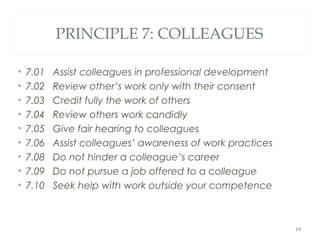The document provides an overview of the history and development of the Software Engineering Code of Ethics. It discusses how a joint steering committee was formed in 1994 by the IEEE and ACM to establish standard definitions and ethical standards for software engineering. This led to the formation of an international task force to draft the code. Several drafts were reviewed by the professional societies, and Version 5.2 was unanimously adopted in 1998. The code establishes 8 fundamental principles for software engineers regarding their products, public welfare, professional judgment, obligations to employers and clients, management duties, responsibilities to the profession and colleagues, and personal development.




































